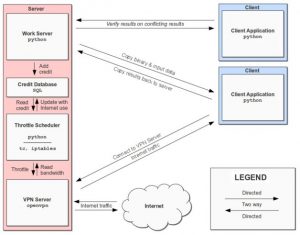Free Internet
Free Internet is a model for free Internet service. The Free Internet network consists of an ISP (Internet Service Provider) server and its customers’ computers, its clients. The ISP runs a distributed system runs on top of the clients’ computers, using the central ISP server to coordinate the distributed application.
In practice, a third party such as a business, scientific laboratory, or University, will architect the distributed application to run on the Free Internet infrastructure.
Undoubtedly, the gap between Internet users and non-Internet computer users in the United States is money. As Internet service from isps (Internet Service Providers) becomes more affordable, the gap will become slim. The Free Internet Project aims to immediately close this gap by giving computer owners an alternate means with which to pay for Internet Service. Instead of using money to pay for Internet, users will offer a percentage of their computing power to the isp. By using this model to complement the existing Internet service model, it will be demonstrated that the isp can increase their profit and customer pool.
Every isp is a potential customer for the Free Internet Project. Nearly 80% of the people in the United States of America use the Internet . If every U.S. ISP adopted this project and subsequently implemented it for all their customers, the Project would have 240 million people in 2010.
The U.S. population is 300 million compared to the world’s nearly 7 billion; however, the global Internet community continues to grow every second. Ideally, every person with a computer on the planet would access the Internet through Free Internet, an innovative and mutually beneficial product for ISPs and individuals alike.
-
If you would like a photo and short bio added please contact the Department of Computer Science.


